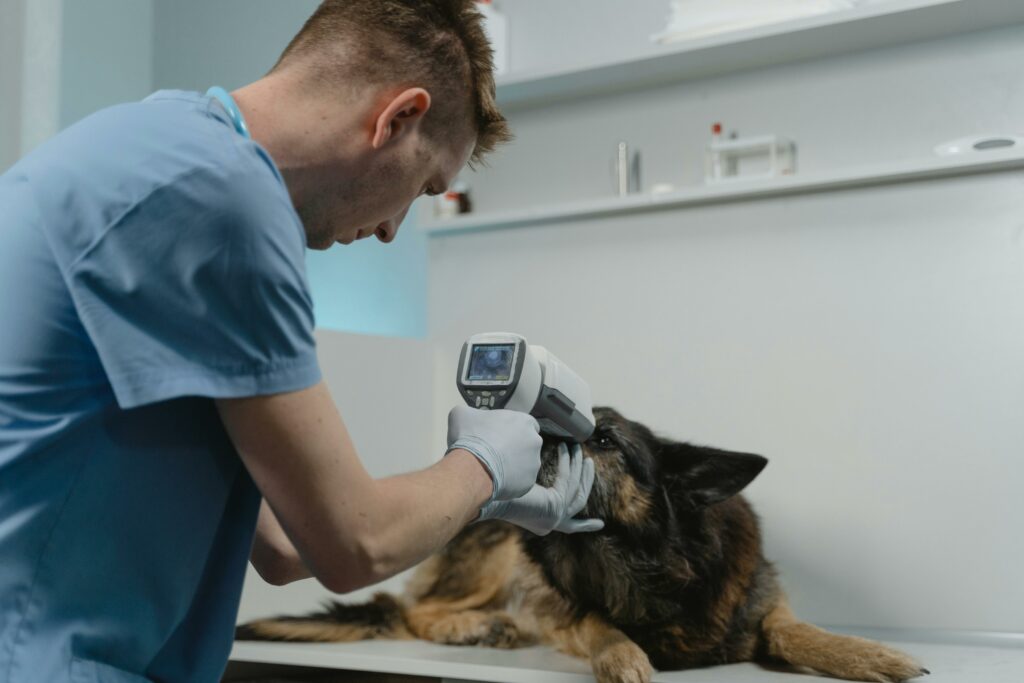Pyometra is a serious infection that occurs in the uterus of female dogs. It arises from hormonal fluctuations that lead to the accumulation of pus within the uterus. Prompt veterinary intervention is crucial when dealing with this life-threatening condition. In this blog, we will explore the typical causes, symptoms, and treatment options for pyometra in dogs.
Why do dogs get Pyometra?
Pyometra is caused by hormonal changes in a female dog’s reproductive tract. It also occurs due to bacterial infection, most commonly by E. coli. This usually happens during the dog’s estrus or heat cycle, when the cervix is more relaxed, which allows bacteria to ascend from the vagina into the uterus. When the uterus is in a normal state, it creates an environment that is unfavorable for bacterial survival. However, if the uterine wall becomes thickened or develop cysts, it provides ideal conditions for the bacteria to grow. Moreover, in these abnormal conditions, the muscles of the uterus are unable to contract properly due to either the thickened uterine wall or the presence of the hormone progesterone. As a result, bacteria that enter the uterus are unable ro be expelled.
Pyometra can develop in any sexually intact young to middle-aged dogs, but it is more frequently seen in older dogs. Usually, the dog has been in heat within the previous four weeks. Over time, after multiple estrus cycles without pregnancy, the uterine wall undergoes certain changes that increase the risk of developing pyometra. Generally, pyometra occurs between two to eight weeks after the last heat cycle
What are the symptoms of Pyometra?
The symptoms experienced by a dog with pyometra depend on whether the cervix is open or closed. If the cervix remains open, there will be a discharge of pus from the uterus that can flow out through the vagina. This discharge may be noticeable on the skin or hair under the tail, as well as on the bedding and furniture where that dog has been resting. More severe symptoms will be experienced by our furry friend when the cervix is closed.
Signs of systemic illness that a female dog with pyometra can experience are the following:
- Vaginal discharge
- Lethargy
- Depression
- Poor appetite
- Increased thirst and urination (polydipsia and polyuria)
- Distended or painful belly
- Vomiting
- Fever
- Pale gums
- Weakness
Female dogs that are examined early in the progression of pyometra may only display a slight vaginal discharge and show no other signs of illness. However, most dogs with pyometra are typically seen at a later stage of the disease. If a female dog is very sick, drinking more water than usual, and has not been spayed, it is important to suspect pyometra, especially if there is a vaginal discharge or a painful and enlarged abdomen.

How is Pyometra diagnosed in dogs?
A veterinarian will use the following tests to confirm a diagnosis:
- Ultrasoud or Xrays that help in identifying enlarged, fluid-filled uterus
- Blood work
- Urine sample
- Vaginal cytology
Dogs with pyometra often exhibit a significant increase in their white blood cell count. Additionally, there is often an elevation of globulins, which is a type of protein associated with the immune system found in their blood. The urine of these dogs typically has a very low specific gravity or concentration due to the harmful effects of bacteria on the kidneys. However, these changes are not specific to pyometra and can be present in any dog with a severe bacterial infection.
In cases where the cervix is closed, X-rays of the abdomen can often reveal an enlarged uterus. On the other hand, if the cervix is open, the uterine enlargement may be minimal, making it difficult to reach a conclusive diagnosis through X-rays alone. In such cases, an ultrasound examination can be helpful in identifying an enlarged uterus and distinguishing it from a normal pregnancy.
How is Pyometra treated?
Pyometra is a serious medical condition that requires prompt treatment, which includes administering intravenous fluids, giving antibiotics and spaying or ovariohysterectomy.
The most effective treatment for pyometra is surgical removal of the ovaries and uterus (spaying). In which, dogs that are diagnosed early in the course of disease are suitable candidates for the operation. However, in severe cases, certain dogs require more intensive care and monitoring for signs of sepsis, dehydration, shock, and anemia. They also require a more complicated surgical procedure and a longer period of hospitalization. IV fluids are crucial in stabilizing dogs before and after surgery, whereas antibiotics are given two weeks post-operatively.
Can I prevent my dog from getting Pyometra?
Yes, pyometra can be completely prevented by spaying a dog before any infection develops in the uterus. According to Cornell Richard Riney Canine Health Center, it is recommended to perform a spay procedure to remove the ovaries and uterus in order to prevent pyometra. If a dog is intended for breeding, it is important to breed them at the appropriate age to minimize the risk of developing pyometra. Opting for spaying your canine buddy while they are young and in good health is a safer and more cost-effective choice compared to waiting for an emergency spay due to pyometra.
What can be the outcome?
If left untreated, pyometra can be fatal due to severe infection and sepsis. However, the prognosis is generally favorable when the condition is diagnosed early and treated with surgery. Dogs who develop sepsis or have a ruptured uterus tend to have a poorer prognosis. Dogs treated with medical interventions have a high risk of a recurrence of infection.
Remember that early diagnosis lowers the risk of complications!












